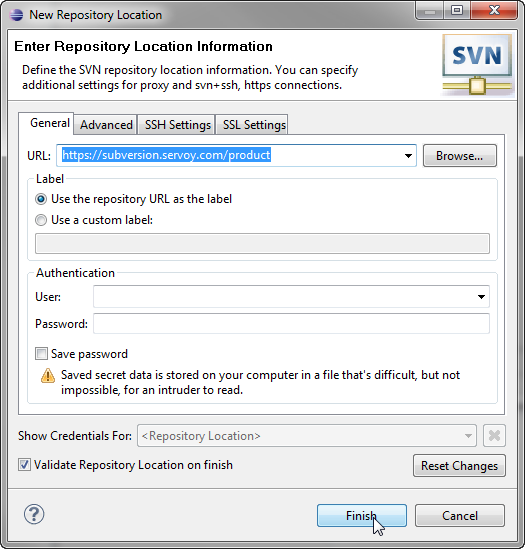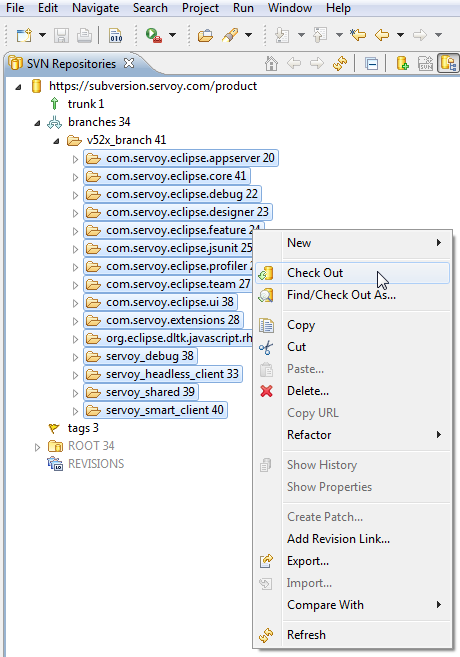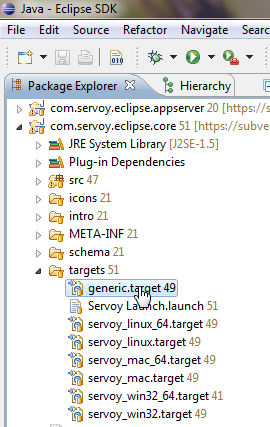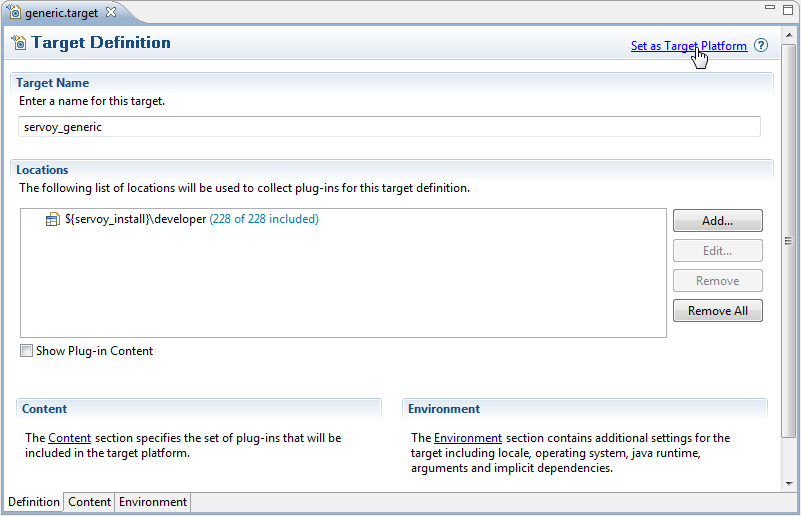Page History
...
Quick start for the impatient
- Install Servoy Developer 5.2
- Run Servoy Developer and install the SQL Explorer plugin and close Servoy Developer again
- Install an Eclipse distribution that contains the plugin development tools for Eclipse (PDE), for example Eclipse Classic
- Setup a String Substitution variable named "servoy_install" which points to the installation directory of the previously installed Servoy Developer
- Create a ClassPath variable named 'WEBSTART' that points to javaws.jar of the used JVM
- Checkout the open source Servoy projects from https://subversion.servoy.com/product/branches/v52x_branch/.
- Download the builds of the Servoy Server libraries from http://build.servoy.com/latest/servoy_v52x_branch/ who's name postfix matched the value of the releaseNumber variable in the ClientVersion class of the checked-out source code and place them in
...
- . Remove any other version of the same file if it exists.
- Setup a Target Platform by:
- Opening the correct .target file, located in the targets directory of the "com.servoy.eclipse.core" project:
- generic.target when running Eclipse and Servoy Developer both under either a 32 or 64 JVM OR
- the .target file that matches the platform and JVM on which Servoy Developer runs. In this scenario, also add the JVM that Servoy Developer uses as Execution environment to the Eclipse installation and mark it as default.
- Clicking the link "Set as Target Platform" of the Target editor
- Opening the correct .target file, located in the targets directory of the "com.servoy.eclipse.core" project:
- Create a Launch Configuration (and directly start a debug session) by right-clicking the "Servoy Launch.launch" file in the "target" directory of the "com.servoy.eclipse.core" project and selecting Debug as > Servoy Launch"
Before getting started: 32 or 64 bit installation
...
Setup a connection to the Servoy SVN:
- Open the SVN Perspective: Window > Open Perspective > Other > SVN Repository Exploring
Note Installing an SVN Team Provider Installing an SVN Team Provider If the SVN Repository Exploring perspective is not available, most likely there is no SVN Team Provider installed. For more information on installing an SVN Team Provider see SVN Team Provider
- Add a new Repository Location: File > New > Repository Location
- Specify the URL 'https://subversion.servoy.com/product' and click 'Finish'
- Specify the URL 'https://subversion.servoy.com/product' and click 'Finish'
Checkout the Servoy projects:
- Expand the tree structure under the newly created Repository Location to the desired version to work on. Make sure to select the version of the projects that match the version of the previously installed Servoy Developer.
- Select all the projects
- Right-click one of the selected projects and select "Check Out" from the context menu
Setup the Target Platform: The Target Platform setting provides the Eclipse instance with information on the Servoy Developer installation, namely whether it's installed to run on a 32 or 64 bit Java virtual Machine (JVM). The checked out Servoy projects already contain the target setup files for different platform/JVM combinations:
- Generic
- Mac OSX
- Mac OSX 64 bit
- Windows 32 bit
- Windows 64 bit
- Linux
- Linux 64 bit
Tip Check the JVM setup of Eclipse/Servoy Developer Check the JVM setup of Eclipse/Servoy Developer To check if Eclipse/Servoy Developer runs on a 32 or 64 bit JVM follow the following steps:
- Open Eclipse/Servoy Developer
- Go to Help > About Eclipse/About Servoy Developer > Installation Details > Configuration tab and look for the text '-arch'.
- If the text is followed by 'x86', Eclipse/Servoy Developer runs on 32 bit. If it is followed by 'x86_64', Eclipse/Servoy Developer runs on 64 bit
- Switch to the Java Perspective: Window > Open Perspective > Java
- Expand to com.servoy.eclipse.core > target in the Package Explorer
- Open (double-click) the correct .target file:
- when Eclipse and Servoy Developer both run on either a 32 or 64 bit JVM, open the generic.target file
- otherwise, open the file that matches the Servoy Developer environment
- Click the 'Set as Target Platform'. This will setup the Target Platform correctly, after which projects will be build and should compile without error.
- When using a mixed setup (generic.target is NOT used), the following additional steps are required:
- Add the JVM that is used by Servoy Developer to the Eclipse instance:
- Open window > Preferences > Java > Installed JREs and click "Add"
- Select "Standard VM" and click "Next"
- Select the directory of the JVM used by Servoy Developer as "JRE home" and click "Finish"
- Due to a bug in Eclipse: close the Preferences window
- Open Window > Preferences > Java > Installed JREs > Execution Environments
- Select the correct Execution Environment (the correct version of J2SE/JavaSE) and check the checkbox besides the name of the JRE under "Compatible JREs"that was added in the previous step
- Add the JVM that is used by Servoy Developer to the Eclipse instance:
Update Servoy Server libraries in the Servoy Developer installation: In order to also be able to start debug clients from Servoy Developer launched from the source code, it is required to use the correct version of several libraries of the Servoy Application Server.
Download the builds of the Servoy Server libraries from [http://build.servoy.com/latest/servoy_v52x_branch/|http://build.servoy.com/latest/servoy_v52x_branch/] who's name postfix matched the value of the releaseNumber variable in the ClientVersion class of the checked-out source code and place them in <servoy_install/developer/plugins> . Remove any other version of the same file if it exists.
...



